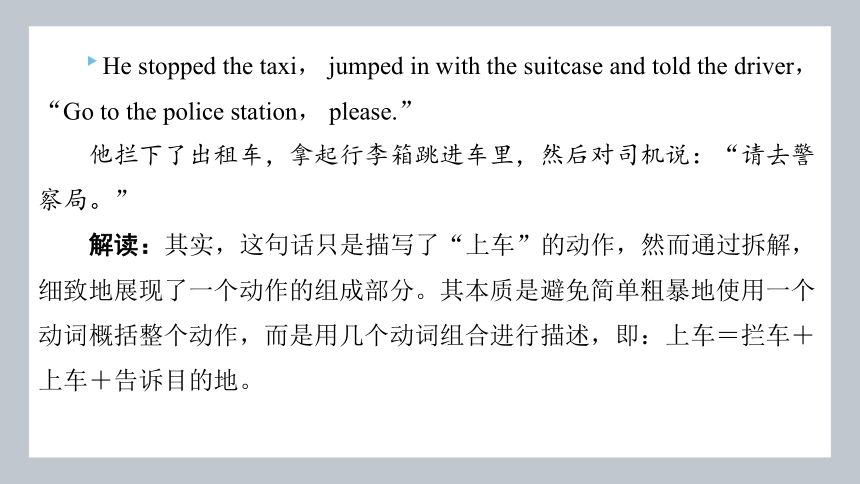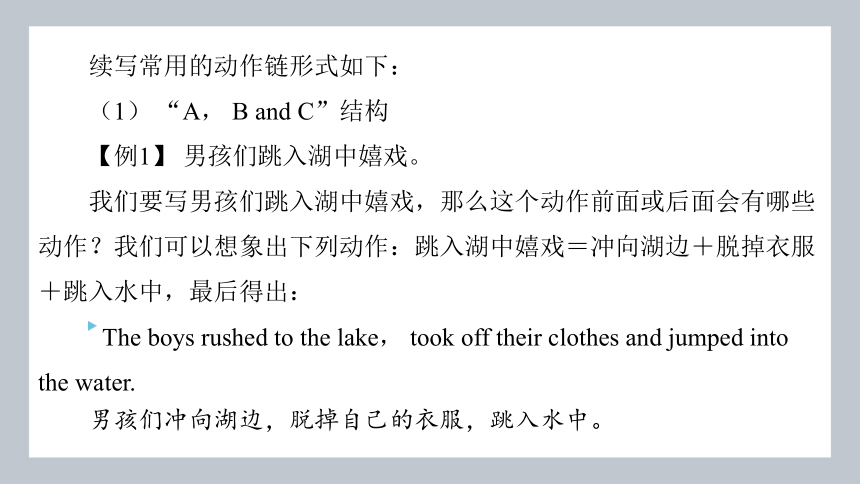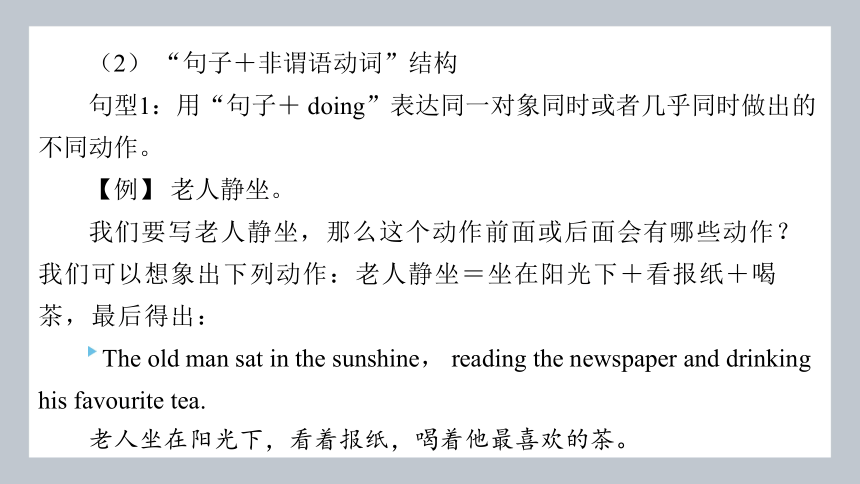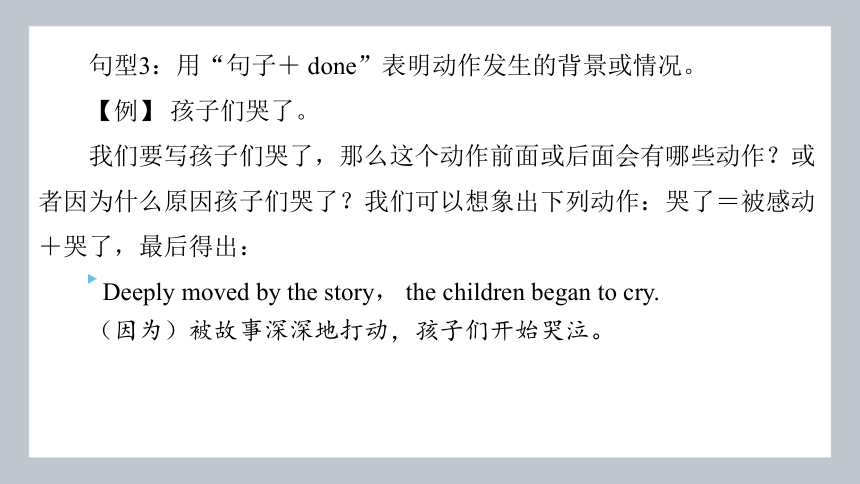2024年高考二轮复习英语专题突破题型六 :读后续写 第四节 细节描写来助力 课件 (共65张PPT)
文档属性
| 名称 | 2024年高考二轮复习英语专题突破题型六 :读后续写 第四节 细节描写来助力 课件 (共65张PPT) |  | |
| 格式 | pptx | ||
| 文件大小 | 606.4KB | ||
| 资源类型 | 教案 | ||
| 版本资源 | 通用版 | ||
| 科目 | 英语 | ||
| 更新时间 | 2024-04-17 22:28:17 | ||
图片预览












文档简介
(共65张PPT)
题型六 读后续写
第四节 细节描写来助力
一、 动作描写巧用动作链
动作描写是对人物的行为、动作的描写。成功的动作描写可以反映
人物的心理活动,可以让故事中的人物更加鲜活,个性特点更加鲜明。
在进行动作描写时要注意以下几点。
1 善用动作链
在描写动作时,要学会细化动作,把动作过程分解成一连串细
微的动作,形成动作链,写出动作的连贯性,这样才能使动作描写
具有画面感,使人物更立体、丰满。动作描写最常用的方法就是动
作三连法。例如:
He stopped the taxi, jumped in with the suitcase and told the driver,
“Go to the police station, please.”
他拦下了出租车,拿起行李箱跳进车里,然后对司机说:“请去警
察局。”
解读:其实,这句话只是描写了“上车”的动作,然而通过拆解,
细致地展现了一个动作的组成部分。其本质是避免简单粗暴地使用一个
动词概括整个动作,而是用几个动词组合进行描述,即:上车=拦车+
上车+告诉目的地。
She would get out of the car excitedly, laughing and dancing around.
她会兴奋地下车,笑着在周围蹦蹦跳跳。
解读:这里描写的是一个比较粗线条的人物。动作描写完整地描述
了这个人物下车时及下车后的表现,即:下车=下车+笑+跳。
(2021·浙江卷)Summers in the mid-70s were spent at home
shooting baskets, hitting a baseball, or throwing a football, preparing for
my future as a quarterback on a football team.
70年代中期的夏天(我)要么在家里练习投篮,要么打棒球,要么
扔橄榄球,为将来成为橄榄球队的四分卫做准备。
解读:在这句话中,作者用shooting、 hitting、 throwing和preparing
这几个动词描写了作者在家里所做的事情。
续写常用的动作链形式如下:
(1) “A, B and C”结构
【例1】 男孩们跳入湖中嬉戏。
我们要写男孩们跳入湖中嬉戏,那么这个动作前面或后面会有哪些
动作?我们可以想象出下列动作:跳入湖中嬉戏=冲向湖边+脱掉衣服
+跳入水中,最后得出:
The boys rushed to the lake, took off their clothes and jumped into
the water.
男孩们冲向湖边,脱掉自己的衣服,跳入水中。
【例2】 女人抱住儿子。
我们要写一个女人抱住儿子,那么这个动作前面或后面会有哪些动
作?我们可以想象出下列动作:抱住儿子=冲向前+蹲下+一把抱住,
最后得出:
She dashed forward, squatted down and gathered her son in her arms.
她冲向前,蹲下,把儿子拢过来抱在怀中。
(2) “句子+非谓语动词”结构
句型1:用“句子+ doing”表达同一对象同时或者几乎同时做出的
不同动作。
【例】 老人静坐。
我们要写老人静坐,那么这个动作前面或后面会有哪些动作?
我们可以想象出下列动作:老人静坐=坐在阳光下+看报纸+喝
茶,最后得出:
The old man sat in the sunshine, reading the newspaper and drinking
his favourite tea.
老人坐在阳光下,看着报纸,喝着他最喜欢的茶。
句型2:用“句子+ having done”凸显同一对象做出的动作的先后
关系。
【例】 没有买到票。
我们要写没有买到票,那么这个动作前面或后面会有哪些动作?我
们可以想象出下列动作:没有买到票=排队排了很久+被告知票卖完
了,最后得出:
Having queued for 3 hours, he was told that the tickets had sold out.
排了三个小时的队,他被告知票卖光了。
句型3:用“句子+ done”表明动作发生的背景或情况。
【例】 孩子们哭了。
我们要写孩子们哭了,那么这个动作前面或后面会有哪些动作?或
者因为什么原因孩子们哭了?我们可以想象出下列动作:哭了=被感动
+哭了,最后得出:
Deeply moved by the story, the children began to cry.
(因为)被故事深深地打动,孩子们开始哭泣。
2 精准使用动词
在英语中,表现一个动作时往往有许多动词可以选择,但这些
词的意思往往有些许差别。我们在重点刻画某个特定的动作时,一
定要选取含义明确且具象的动词,而不用抽象或者虚化的动词。这
就要求我们在积累动作词汇时,准确地理解词汇的含义,掌握近义
词的区别,从而选取最合适、最精准的词,达到细腻、生动的描写
效果。对比下面几组句子。
Group 1:
She said something to him in a low voice.
她低声对他说了些什么。
She leaned over and whispered something in his ear.
她探过身去附耳跟他说了些什么。
解读:第一句中的said something to him没有任何感彩,只是简
单陈述事实,而第二句中使用了具体化的表示“说”的动词whispered,
同时还配有动作leaned over,增强了句子的画面感。
Group 2:
An enormous whale jumped out of the water and then dropped again.
一头巨大的鲸鱼跳出水面,又掉了下去。
An enormous whale threw itself out of the water and then crashed
down again.
一头巨大的鲸鱼跃出水面,然后又坠落下去。
解读:第一句中的jumped和dropped不能体现出这头鲸鱼enormous的
特点,而第二句中的threw和crashed则更为精确地让读者感受到了鲸鱼
的重量和其动作的力量。
Group 3:
“I’ll never forgive you,” Peter said, and then he walked out of
the room without a backward glance.
彼得说:“我将永远也不会原谅你。”然后他头也不回地走出
了房间。
“I’ll never forgive you,” Peter said, and then he stormed out of
the room without a backward glance.
彼得说:“我将永远也不会原谅你。”然后他头也不回地冲出
了房间。
解读:通过I’ll never forgive you可以判断出彼得非常生气。而第一
句中用walked完全体现不出他的生气,换成stormed后,表示彼得头也不
回地冲出房间,更能体现出人物的情感。
3 “秀”出文章意境
“秀,不要说”这种写作技巧广泛应用于写作中。如果我们写作时
把想要表达的内容用具体的文字描述代替,读者一定会更深刻地领会到
略去的内容。这种写作手法能够最大限度地调动读者的积极性和参与
性,从而丰富读者的阅读体验。例如:
Mary felt cold. (说)
玛丽感到很冷。
Mary pulled her collar up, tightened her scarf, shoved her hands
into her pockets and turned her face away from the biting wind. (秀)
玛丽拉起衣领,系紧围巾,把双手插进口袋里,转过脸去躲避刺骨
的寒风。
解读:第一句话直接告诉读者玛丽很冷,第二句话则通过一系列的
动作体现玛丽很冷。第二句话中的动作描写让读者真真切切地感受到了
“冷”,两句话所体现的艺术效果不言而喻。
4 添加修饰成分,使描写更生动
动作描写中最常见的修饰成分就是状语,如副词、介词短语等。在
体现动作的迅速和短暂时,我们可以使用以下修饰语: suddenly、
immediately、 instantly、 swiftly、 promptly、 hastily、 speedily、
rapidly、 without pausing、 without delay等。
另外,把动作和表情、心理结合起来描写,能写出人物的动作所表
现出的神态、想法,从而更生动地刻画人物性格。例如:
He stood leaning against the wall, with the mouth numbly open,
unable to speak. (表达伤心)
他靠墙站着,木然地张着嘴,说不出话来。
She hugged them tightly to her chest, and at last she was able to look
up with tearful eyes and a smile on her face. (幸福的场景)
她把它们紧紧地抱在胸前,终于,她能够抬起头来,眼里含着泪
水,脸上带着微笑。
He gave a jump, twirled, ran a few steps, stopped, looked all
around, sniffed the warm afternoon air, and then set off walking into the
orchard. (开心的场景)
他(先是)蹦跶了一下,转了转,跑上几步,停了下来,四下望了
望,嗅了嗅午后暖洋洋的空气,然后走进了果园。
随堂巩固1
一、 根据提示进行句型升级
1. 当主持人宣布她获奖时,她兴奋极了。
When the host announced that she won the prize, she felt thrilled.
→(1) When the host announced that she won the prize,
(她激动得两眼发光).
→(2) When the host announced that she won the prize,
(她激动得心怦怦跳).
her eyes
twinkled with excitement
her heart was
thumping with excitement
2. 一听到那个坏消息,她悲伤不已。
Upon hearing the bad news, she felt extremely sad.
→(1) Upon hearing the bad news,
(她的心很痛,泪水顺着她的脸颊流下
来).
→(2) Upon hearing the bad news,
(她突然感到一阵悲伤,忍
不住痛哭).
her heart ached, tears
streaming down her cheeks
she felt seized by a burst of
sadness and couldn’t help crying bitterly
二、 完成句子
1. (2023·浙江卷)离开家时,我不禁想知道这会儿情况如何了。
, I couldn’t help wondering how it was getting on
now.
2. (2021·新高考Ⅰ卷)看到他们低垂双眼,他叫他们打扫厨房,自己帮
他们给妈妈做早餐。
, he told them to clean up the kitchen
while he helped them make breakfast for their mother.
Leaving the house
Seeing their eyes downcast
二、 心理描写活用技法
心理描写是指对人物在一定的环境中的心理状态、精神面貌和内心
活动进行描写。心理描写可以细腻、生动、真实地展示人物的心路历
程,从而更好地揭示出人物的性格特点。人的心理活动复杂多样,这决
定了心理描写具有多种多样的表现形式。
1 直接描写
直接描写是最常见的一种心理描写法,直接写人物的所思所想,通
过描写人物的欢乐和悲伤、矛盾和愁郁、忧虑和希望,帮助读者看到人
物的内心世界。直接描写的句子中通常含有think、 know、 realize、
hope、 want等关键词。例如:
Feeling better now, Jane began to walk along the stream and hoped it
would lead her to the lake.
现在简感到好一些了,她开始沿着小溪走,希望它能把她带到
湖边。
Lying awake at night, Jane wanted very much to be with Tom and her
family.
简夜晚躺在床上睡不着,非常想和汤姆以及她的家人在一起。
2 巧用细节描写而非笼统描写
情绪描写需要利用相关细节性的单词或短语,将情感体现在细
微处。
Lily smiled. (笼统版)
莉莉笑了。
Lily wore a shining smile on her face. (细节版)
莉莉脸上挂着灿烂的笑容。
She stood silently, in tears. (笼统版)
她静静地站着,哭了。
She stood silently,(with)tears rolling/streaming down her face.
(细节版)
她静静地站着,眼泪顺着她的脸流下来。
3 用“无灵主语”,赋能各项情感
无灵句主要是采用“无灵主语”的句子,即用表示抽象概念、心理
感觉、事物名称或者时间地点,甚至是某个身体部位的名词作主语的句
子。这类句子往往带有拟人化(personification)的修辞色彩。
His eyes twinkled/sparkled/shone with pleasure.
他的眼中闪烁着愉悦的光芒。
A gentle smile spread over her face.
温柔的微笑在她脸上绽开。
Excitement took my breath away when he broke the news to me that I
was admitted to the most famous law university.
他带给我消息说我被最著名的法律大学录取时,我激动得喘不
过气来。
Courage deserted him.
他没有了勇气。
4 使用修辞提档次
运用修辞手法会加强语句与整篇文章的感染力,增强表达效
果,引发读者联想。常用的修辞手法有比喻、拟人、夸张、排比
等。适当的修辞可以为句子增光添彩,因此我们可以尝试用修辞手
法来升级、优化表达。
(1) 排比
排比是指把三个或三个以上结构相同或相似、内容相关、语气一致
的短语或句子排列在一起来增强语势、强调内容、加重感情。使用排比
句往往是为了表达内容上的顺序先后、程度轻重、范围大小,以便逐层
深入。
I am very happy because my parents give me life, my teachers give
me knowledge, my friends give me friendship, and society gives me
warmth.
我非常幸福,因为父母给予我生命,老师给予我知识,朋友给予我
友谊,社会给予我温暖。
(2) 比喻
比喻就是根据联想,抓住不同事物的相似之处,用具体、生动的事
物来代替抽象、难理解的事物。比喻的使用能使语言生动形象。
The scenery along the journey is just like a breathtaking landscape
painting.
沿途的景色就像一幅令人叹为观止的风景画。
The icy wind started howling, cutting my face like a sharp knife.
凛冽的风开始呼啸,像锋利的刀一样割我的脸。
(3) 拟人
拟人可以使抽象的事物具体化,使无生命的东西活跃起来,使事物
生动形象、具体可感,以此让读者共情。
The breeze gently kissed her cheeks.
微风轻柔地亲吻着她的脸颊。
Spring is coming and flowers are laughing.
春天来了,花儿笑了。
The frogs are giving a concert—a mixed chorus.
青蛙在举办音乐会——混声合唱。
(4) 夸张
夸张是指为了达到某种表达效果,对事物的形象、特征、作用、程
度等方面刻意夸大或缩小。夸张可以加强语势,增强表达效果。
My blood froze.
我的血液凝固了。
It made me jump out of my skin.
它使我大吃一惊。
When she heard the bad news, a river of tears poured out.
当她听到这个坏消息时,她泪流成河。
1. 看到那只凶恶的狼,我感到很害怕。
At the sight of the fierce wolf, I felt very scared.
→(1) At the sight of the fierce wolf, I felt so scared that
(我喉咙发紧,膝盖发软).
→(2) At the sight of the fierce wolf, I
(吓呆了,不敢动弹).
→(3) At the sight of the fierce wolf, I
(感到无比恐惧,手掌出汗).
my throat
tightened and my knees felt weak
froze with terror, too scared
to move an inch
was seized by a strong sense
of horror and my palms were sweating
随堂巩固2
根据提示进行句型升级
2. 当妈妈亲吻他的脸颊时,宝宝开心极了。
When his mother kissed him on the cheek, the baby was very happy.
→(1) When his mother kissed him on the cheek, it seemed as if the
baby (非常开心).
→(2) When his mother kissed him on the cheek,
(眉开眼笑,笑容照亮房间).
→(3) When his mother kissed him on the cheek, the baby
(高兴得手舞足蹈).
were on top of the world
the baby’s face
beamed and his smile lit up the room
danced
with joy
3. 她感到非常羞愧。
She felt very ashamed.
→(1) She felt so ashamed that (她
感到脸在发烫).
→(2) So ashamed was she that she could
(感到血一下子涌上了她的脸).
→(3) So ashamed did she feel that she (快哭
了).
she could feel her face burning
feel the blood rush to her
face
was close to tears
4. 谢尔顿感到非常生气。
Sheldon felt very angry.
→(1) Sheldon felt so angry that he
(冲出房间,砰地把身后的门关上).
→(2) (怒火中烧), Sheldon shook his fist at
me.
→(3) Filled with anger/fury, Sheldon
(说不出话).
stormed out of the room,
slamming the door behind him
Boiling with rage
was unable to utter a single
word
三、 对话描写坚决不单一
对话描写能在一定程度上让人物把自己的心理活动说出来。对话可
以是两个人之间的对话,也可以是几个人之间的相互交谈。描写人物的
语言,不但要做到个性化,还要体现出人物说话的艺术性。成功的对话
描写能鲜明地展示人物的性格,生动地表现人物的思想感情,深刻地反
映人物的内心世界。读后续写中对话描写要遵循以下三个原则:
控制对话的比重。读后续写中的对话描写要注意在段落中的比重
问题,切忌全以对话或大部分以对话代替其他细节描写。
对话内容应符合人物的身份特征,否则写作效果会打折扣。
读后续写中所写对话应该紧扣一个中心或话题,且这个中心或者
话题需要与全文的主题一致,这样才能使文章思路清晰,使对话有意
义,否则将会影响文意的表达和故事情节的发展。
读后续写中对话描写常见的几种方式:
1 对话标签在前
Mrs Meredith said to the children, “You may send him the popcorn
every Saturday morning if you make the popcorn for him. John, will you
agree to take charge of the work?”
梅雷迪思太太对孩子们说:“如果你们给他做爆玉米花,你们可以
每个星期六早上送给他。约翰,你同意负责这项工作吗?”
2 对话标签在后
“I’m going to miss you so much, Poppy,” said the tall, thin
teenager.
这个又高又瘦的青少年说:“我会非常想念你的,波比。”
3 对话标签在句中
“I wish we could help Bernard to earn money,” said Clara. “His
family are suffering.”
“我希望我们能帮助伯纳德赚钱。”克莱拉说,“他的家人在受
苦。”
常用技巧:
(1) 变着动词“说”。
(2021·新高考Ⅰ卷)At the sight of the meal, the mother asked,
“Where did you get this breakfast?”
看到餐食,妈妈问:“你们在哪里买的早餐?”
(2023·新高考Ⅰ卷)Holding my hands, he said,
“Congratulations! You are a good writer, so keep writing.”
他握着我的手说:“恭喜!你是个好作家,所以要继续写下去。”
“As you can see, Mark treasured the book,” he added.
他补充说:“如你所见,马克珍惜这本书。”
Robby explained with his eyes red, “I wanted to make the day
special.”
罗比红着眼睛解释道:“我想让这一天变得特别。”
“Don’t let go of the rope! Keep calm!” yelled Dad.
“别放开绳子!保持冷静!”爸爸喊道。
I wondered, “Is he running for help or is he running away and
leaving me sliding to the bottom of the water?”
我自忖道:“他是跑去求救呢还是跑开了,让我一个人滑到水
底?”
He continued, “Without your encouragement, I couldn’t have
flown the kite so high. I really had a wonderful time today.”
他继续说: “没有你的鼓励,我就不能把风筝放得如此高。 我今
天过得非常开心。”
(2) 增加与“说”并列的谓语动词,还可加上分词或状语从句来
修饰。
The father picked up the dog, knelt down and said in a soft voice,
“It’s yours now.”(picked、 knelt与said是并列的谓语动词,三个动词
连用,有效增强画面感。)
父亲抱起狗,跪下来,用轻柔的声音说:“现在它是你的了。”
“I want that one,” the boy said, pointing to the little dog.(现在
分词短语作状语,修饰动词said。)
男孩指着小狗说:“我想要那个。”
(3) 增加细节描写,让人物语言“活”起来。
(2021·新高考Ⅰ卷)“Why did you cook by yourselves? Don’t you
know it’s dangerous?” shouted the father with anger.
爸爸生气地喊道:“你们为什么自己煮饭?难道你们不知道这很危
险吗?”
(2022·新高考Ⅰ卷)I shouted crazily, “Come on, David!”
我疯狂地喊道:“加油,戴维!”
“Oh! You’re here! Good morning, Ms Li! I’m Cathy,” she
said with a smile.
她微笑着说:“哦!您在这儿!早上好,李女士!我是凯茜。”
“Absolutely!” replied John, excitement shining in his eyes.
约翰回复道:“当然!”他眼里闪着兴奋的光芒。
“All is going well,” Dad answered in a gentle voice, calm and
confident.
爸爸冷静且自信,用温柔的声音答道:“一切都很顺利。”
随堂巩固3
完成句子
1. “Surely, I will!” (约翰用坚定的
声音回答道).
2. “We could stay to take more pictures,” Elli said. (我
告诉她), “Let’s pack up our things and leave here. We have already
taken a lot of amazing pictures.”
3. “What should we do to cheer Poppy up?”
(爸爸有些焦急地问道). “We’ve tried everything.”
John replied in a firm voice
I told her
asked Dad, a bit
anxiously
4. “Your performance is amazing!” Mr Smith
(大声表扬自己的儿子).
5. James (耐心地安慰她), “Don’t
worry about your son.”
praised his son in a
loud voice
comforted her with patience
四、 情景交融文中巧衬托
环境描写是指对人物所处的具体的社会环境和自然环境的描写。其
中社会环境是指能反映社会、时代特征的建筑物、场所、陈设以及民
俗、民风等。自然环境是指自然界的景物,如季节变化、风霜雨雪、山
川湖泊等。环境描写往往需要综合运用记叙、描写、抒情等表达方法,
是自然景色、社会环境、人物活动等的集中表现。
描写自然环境时要做到有声有色、有味道、有质感、有动态、有画
面感。可以借助描写天气、描写自然景物等来衬托故事中人物的心境或
情绪。
描写社会环境时可以通过描写某些社会现象、交代某个故事发生的
具体背景等来烘托人物当时的心情或者为续写的下一步作铺垫。
1 “情景交融”法
用一个公式来表达就是“写景+感受”。写景后,再添加情感描
写,就是指:在景物描写之后,加上一两句自己的情感态度。这样做的
整体效果就是:情景交融。当然,如果想产生“留白启发思考”的效
果,那么就没有必要添加情感描写了。
The wind was howling and the rain was pouring down, whipping
against the tree branches.
风呼啸着,雨倾盆而下,拍打着树枝。
The morning sunlight flooding in through the curtain, a ripple of
satisfaction and happiness ran through my heart.
早晨的阳光从窗帘里洒了进来,一股满足感和幸福感在我的心
中荡漾。
I was overwhelmed by the power of nature, horror creeping up on
me.
我被大自然的力量征服了,我不知不觉感到恐惧。
Basking in the sunshine and admiring the fantastic scenery, we
headed for the destination.
我们沐浴在阳光中,欣赏着美妙绝伦的风景,前往目的地。
2 比喻法
在描写环境时还可以用比喻的修辞手法,用like即可,并交代、突
出特点。如果总结成公式就是“写景+比喻+特点”。
Night fell. The darkness was thin, like shabby dress that had been
worn for many winters and let the cold pierce the bones. Then the moon rose.
夜幕降临。夜色稀薄,犹如穿了数个冬季的破旧衣服,难以抵御刺
骨的寒冷。然后月亮升起。
Like a lamp, the moon shone from above. The stars twinkled with
curiosity.
月亮在天空中好像一盏灯在发光。星星闪烁着好奇的光芒。
3 活用无灵主语
在环境描写中,常用以下两种表达:
(1) 时间/地点/场景类名词+谓语
常见的时间/地点/场景类名词有silence、 hush、 dusk、 dawn、
morning、 afternoon、 night等。
常用的谓语动词有see、 witness、 find、 fall等。
续写中交代故事的时间或背景时,也可以用无灵主语句表示 发
生了 。
“时间/地点/场景类名词+谓语”的描写有:
A hush fell over the crowd.
人群变得鸦雀无声。
Beijing has witnessed great changes in recent years.
北京近年来经历了巨大的变化。
Dusk found the child crying in the street.
黄昏时,孩子在街上哭。
That chilly afternoon witnessed him trudging in the snow.
那个寒冷的下午,他在雪地里跋涉。
上面这些描写,都是将时间、地点和场景拟人化,从它们的视角
“看到”事件发生。
(2) 自然现象类名词+谓语
常见的自然现象类名词有sun、 sunshine、 moon、 moonlight、
earthquake、 mist、 rain、 fog等。
常用的谓语动词有blanket、 come、 bring、 prevent、 strike、
threaten等。
要是续写时想用环境描写烘托氛围,也可以用无灵主语句。
“自然现象类名词+谓语”的描写有:
A sudden shower killed the wind.
突然下了一阵雨,风停了。
A heavy rain visited the city.
这个城市下过一场大雨。
The thick fog blanketed the field.
浓雾覆盖着田野。
随堂巩固4
一、 根据提示进行句式升级
1. 在早晨的阳光里,薄雾迅速消散了。
The mist cleared rapidly in the morning sun.
→ (with复合结构), the mist cleared
rapidly.
With the morning sun seeing
2. 日落时分,一道红霞笼罩在西山上。
At sunset, a red glow hung over the western mountains.
→ (as引导时间状语从句), a red
glow hung over the western mountains.
3. 随着时间的流逝,春草迅速生长。
The spring grass shot up as time itself speeded up.
→ (with复合结构), the spring grass
shot up.
As the sun went down gently
With time itself speeding up
4. 落叶在凉爽的空气中翩翩起舞,告别甜蜜的夏天,迎接秋天的到来。
Fallen leaves danced up and down in the cool air so that they bade farewell to
the sweet summer and welcomed the autumn.
→ Fallen leaves danced up and down in the cool air,
(现在分词作状语).
bidding farewell to
the sweet summer and welcoming the autumn
二、 完成句子
1. 这是美丽的春季。雪冰融化,植物生长,森林动物从冬眠中醒来。
It was beautiful spring. , the plants
were growing, and the forest animals were waking from their winter sleep.
2. 对这儿潮湿、多云的气候来说,今天的天气很好。
for a wet and cloudy climate here.
The snow and ice were melting
It is lovely weather today
3. 这片荒野春天和夏天都开满了花,十分美丽。空气新鲜极了,鸟也叫
得那么动听。
The moor is so lovely in spring and summer when there are flowers every-
where. The air’s so fresh, and the birds .
4. 一股势不可挡的热浪在大气中涌动,充满了令人不安的不适。
An overwhelming torrent of heat flew through the atmosphere,
.
sing so beautifully
filled
with uneasy discomfort
5. 月亮悬挂在天空中,微笑着。星星挤满了银河,眨着眼睛。
The moon hung in the sky, smiling.
, blinking.
The Milky Way was full of
stars
题型六 读后续写
第四节 细节描写来助力
一、 动作描写巧用动作链
动作描写是对人物的行为、动作的描写。成功的动作描写可以反映
人物的心理活动,可以让故事中的人物更加鲜活,个性特点更加鲜明。
在进行动作描写时要注意以下几点。
1 善用动作链
在描写动作时,要学会细化动作,把动作过程分解成一连串细
微的动作,形成动作链,写出动作的连贯性,这样才能使动作描写
具有画面感,使人物更立体、丰满。动作描写最常用的方法就是动
作三连法。例如:
He stopped the taxi, jumped in with the suitcase and told the driver,
“Go to the police station, please.”
他拦下了出租车,拿起行李箱跳进车里,然后对司机说:“请去警
察局。”
解读:其实,这句话只是描写了“上车”的动作,然而通过拆解,
细致地展现了一个动作的组成部分。其本质是避免简单粗暴地使用一个
动词概括整个动作,而是用几个动词组合进行描述,即:上车=拦车+
上车+告诉目的地。
She would get out of the car excitedly, laughing and dancing around.
她会兴奋地下车,笑着在周围蹦蹦跳跳。
解读:这里描写的是一个比较粗线条的人物。动作描写完整地描述
了这个人物下车时及下车后的表现,即:下车=下车+笑+跳。
(2021·浙江卷)Summers in the mid-70s were spent at home
shooting baskets, hitting a baseball, or throwing a football, preparing for
my future as a quarterback on a football team.
70年代中期的夏天(我)要么在家里练习投篮,要么打棒球,要么
扔橄榄球,为将来成为橄榄球队的四分卫做准备。
解读:在这句话中,作者用shooting、 hitting、 throwing和preparing
这几个动词描写了作者在家里所做的事情。
续写常用的动作链形式如下:
(1) “A, B and C”结构
【例1】 男孩们跳入湖中嬉戏。
我们要写男孩们跳入湖中嬉戏,那么这个动作前面或后面会有哪些
动作?我们可以想象出下列动作:跳入湖中嬉戏=冲向湖边+脱掉衣服
+跳入水中,最后得出:
The boys rushed to the lake, took off their clothes and jumped into
the water.
男孩们冲向湖边,脱掉自己的衣服,跳入水中。
【例2】 女人抱住儿子。
我们要写一个女人抱住儿子,那么这个动作前面或后面会有哪些动
作?我们可以想象出下列动作:抱住儿子=冲向前+蹲下+一把抱住,
最后得出:
She dashed forward, squatted down and gathered her son in her arms.
她冲向前,蹲下,把儿子拢过来抱在怀中。
(2) “句子+非谓语动词”结构
句型1:用“句子+ doing”表达同一对象同时或者几乎同时做出的
不同动作。
【例】 老人静坐。
我们要写老人静坐,那么这个动作前面或后面会有哪些动作?
我们可以想象出下列动作:老人静坐=坐在阳光下+看报纸+喝
茶,最后得出:
The old man sat in the sunshine, reading the newspaper and drinking
his favourite tea.
老人坐在阳光下,看着报纸,喝着他最喜欢的茶。
句型2:用“句子+ having done”凸显同一对象做出的动作的先后
关系。
【例】 没有买到票。
我们要写没有买到票,那么这个动作前面或后面会有哪些动作?我
们可以想象出下列动作:没有买到票=排队排了很久+被告知票卖完
了,最后得出:
Having queued for 3 hours, he was told that the tickets had sold out.
排了三个小时的队,他被告知票卖光了。
句型3:用“句子+ done”表明动作发生的背景或情况。
【例】 孩子们哭了。
我们要写孩子们哭了,那么这个动作前面或后面会有哪些动作?或
者因为什么原因孩子们哭了?我们可以想象出下列动作:哭了=被感动
+哭了,最后得出:
Deeply moved by the story, the children began to cry.
(因为)被故事深深地打动,孩子们开始哭泣。
2 精准使用动词
在英语中,表现一个动作时往往有许多动词可以选择,但这些
词的意思往往有些许差别。我们在重点刻画某个特定的动作时,一
定要选取含义明确且具象的动词,而不用抽象或者虚化的动词。这
就要求我们在积累动作词汇时,准确地理解词汇的含义,掌握近义
词的区别,从而选取最合适、最精准的词,达到细腻、生动的描写
效果。对比下面几组句子。
Group 1:
She said something to him in a low voice.
她低声对他说了些什么。
She leaned over and whispered something in his ear.
她探过身去附耳跟他说了些什么。
解读:第一句中的said something to him没有任何感彩,只是简
单陈述事实,而第二句中使用了具体化的表示“说”的动词whispered,
同时还配有动作leaned over,增强了句子的画面感。
Group 2:
An enormous whale jumped out of the water and then dropped again.
一头巨大的鲸鱼跳出水面,又掉了下去。
An enormous whale threw itself out of the water and then crashed
down again.
一头巨大的鲸鱼跃出水面,然后又坠落下去。
解读:第一句中的jumped和dropped不能体现出这头鲸鱼enormous的
特点,而第二句中的threw和crashed则更为精确地让读者感受到了鲸鱼
的重量和其动作的力量。
Group 3:
“I’ll never forgive you,” Peter said, and then he walked out of
the room without a backward glance.
彼得说:“我将永远也不会原谅你。”然后他头也不回地走出
了房间。
“I’ll never forgive you,” Peter said, and then he stormed out of
the room without a backward glance.
彼得说:“我将永远也不会原谅你。”然后他头也不回地冲出
了房间。
解读:通过I’ll never forgive you可以判断出彼得非常生气。而第一
句中用walked完全体现不出他的生气,换成stormed后,表示彼得头也不
回地冲出房间,更能体现出人物的情感。
3 “秀”出文章意境
“秀,不要说”这种写作技巧广泛应用于写作中。如果我们写作时
把想要表达的内容用具体的文字描述代替,读者一定会更深刻地领会到
略去的内容。这种写作手法能够最大限度地调动读者的积极性和参与
性,从而丰富读者的阅读体验。例如:
Mary felt cold. (说)
玛丽感到很冷。
Mary pulled her collar up, tightened her scarf, shoved her hands
into her pockets and turned her face away from the biting wind. (秀)
玛丽拉起衣领,系紧围巾,把双手插进口袋里,转过脸去躲避刺骨
的寒风。
解读:第一句话直接告诉读者玛丽很冷,第二句话则通过一系列的
动作体现玛丽很冷。第二句话中的动作描写让读者真真切切地感受到了
“冷”,两句话所体现的艺术效果不言而喻。
4 添加修饰成分,使描写更生动
动作描写中最常见的修饰成分就是状语,如副词、介词短语等。在
体现动作的迅速和短暂时,我们可以使用以下修饰语: suddenly、
immediately、 instantly、 swiftly、 promptly、 hastily、 speedily、
rapidly、 without pausing、 without delay等。
另外,把动作和表情、心理结合起来描写,能写出人物的动作所表
现出的神态、想法,从而更生动地刻画人物性格。例如:
He stood leaning against the wall, with the mouth numbly open,
unable to speak. (表达伤心)
他靠墙站着,木然地张着嘴,说不出话来。
She hugged them tightly to her chest, and at last she was able to look
up with tearful eyes and a smile on her face. (幸福的场景)
她把它们紧紧地抱在胸前,终于,她能够抬起头来,眼里含着泪
水,脸上带着微笑。
He gave a jump, twirled, ran a few steps, stopped, looked all
around, sniffed the warm afternoon air, and then set off walking into the
orchard. (开心的场景)
他(先是)蹦跶了一下,转了转,跑上几步,停了下来,四下望了
望,嗅了嗅午后暖洋洋的空气,然后走进了果园。
随堂巩固1
一、 根据提示进行句型升级
1. 当主持人宣布她获奖时,她兴奋极了。
When the host announced that she won the prize, she felt thrilled.
→(1) When the host announced that she won the prize,
(她激动得两眼发光).
→(2) When the host announced that she won the prize,
(她激动得心怦怦跳).
her eyes
twinkled with excitement
her heart was
thumping with excitement
2. 一听到那个坏消息,她悲伤不已。
Upon hearing the bad news, she felt extremely sad.
→(1) Upon hearing the bad news,
(她的心很痛,泪水顺着她的脸颊流下
来).
→(2) Upon hearing the bad news,
(她突然感到一阵悲伤,忍
不住痛哭).
her heart ached, tears
streaming down her cheeks
she felt seized by a burst of
sadness and couldn’t help crying bitterly
二、 完成句子
1. (2023·浙江卷)离开家时,我不禁想知道这会儿情况如何了。
, I couldn’t help wondering how it was getting on
now.
2. (2021·新高考Ⅰ卷)看到他们低垂双眼,他叫他们打扫厨房,自己帮
他们给妈妈做早餐。
, he told them to clean up the kitchen
while he helped them make breakfast for their mother.
Leaving the house
Seeing their eyes downcast
二、 心理描写活用技法
心理描写是指对人物在一定的环境中的心理状态、精神面貌和内心
活动进行描写。心理描写可以细腻、生动、真实地展示人物的心路历
程,从而更好地揭示出人物的性格特点。人的心理活动复杂多样,这决
定了心理描写具有多种多样的表现形式。
1 直接描写
直接描写是最常见的一种心理描写法,直接写人物的所思所想,通
过描写人物的欢乐和悲伤、矛盾和愁郁、忧虑和希望,帮助读者看到人
物的内心世界。直接描写的句子中通常含有think、 know、 realize、
hope、 want等关键词。例如:
Feeling better now, Jane began to walk along the stream and hoped it
would lead her to the lake.
现在简感到好一些了,她开始沿着小溪走,希望它能把她带到
湖边。
Lying awake at night, Jane wanted very much to be with Tom and her
family.
简夜晚躺在床上睡不着,非常想和汤姆以及她的家人在一起。
2 巧用细节描写而非笼统描写
情绪描写需要利用相关细节性的单词或短语,将情感体现在细
微处。
Lily smiled. (笼统版)
莉莉笑了。
Lily wore a shining smile on her face. (细节版)
莉莉脸上挂着灿烂的笑容。
She stood silently, in tears. (笼统版)
她静静地站着,哭了。
She stood silently,(with)tears rolling/streaming down her face.
(细节版)
她静静地站着,眼泪顺着她的脸流下来。
3 用“无灵主语”,赋能各项情感
无灵句主要是采用“无灵主语”的句子,即用表示抽象概念、心理
感觉、事物名称或者时间地点,甚至是某个身体部位的名词作主语的句
子。这类句子往往带有拟人化(personification)的修辞色彩。
His eyes twinkled/sparkled/shone with pleasure.
他的眼中闪烁着愉悦的光芒。
A gentle smile spread over her face.
温柔的微笑在她脸上绽开。
Excitement took my breath away when he broke the news to me that I
was admitted to the most famous law university.
他带给我消息说我被最著名的法律大学录取时,我激动得喘不
过气来。
Courage deserted him.
他没有了勇气。
4 使用修辞提档次
运用修辞手法会加强语句与整篇文章的感染力,增强表达效
果,引发读者联想。常用的修辞手法有比喻、拟人、夸张、排比
等。适当的修辞可以为句子增光添彩,因此我们可以尝试用修辞手
法来升级、优化表达。
(1) 排比
排比是指把三个或三个以上结构相同或相似、内容相关、语气一致
的短语或句子排列在一起来增强语势、强调内容、加重感情。使用排比
句往往是为了表达内容上的顺序先后、程度轻重、范围大小,以便逐层
深入。
I am very happy because my parents give me life, my teachers give
me knowledge, my friends give me friendship, and society gives me
warmth.
我非常幸福,因为父母给予我生命,老师给予我知识,朋友给予我
友谊,社会给予我温暖。
(2) 比喻
比喻就是根据联想,抓住不同事物的相似之处,用具体、生动的事
物来代替抽象、难理解的事物。比喻的使用能使语言生动形象。
The scenery along the journey is just like a breathtaking landscape
painting.
沿途的景色就像一幅令人叹为观止的风景画。
The icy wind started howling, cutting my face like a sharp knife.
凛冽的风开始呼啸,像锋利的刀一样割我的脸。
(3) 拟人
拟人可以使抽象的事物具体化,使无生命的东西活跃起来,使事物
生动形象、具体可感,以此让读者共情。
The breeze gently kissed her cheeks.
微风轻柔地亲吻着她的脸颊。
Spring is coming and flowers are laughing.
春天来了,花儿笑了。
The frogs are giving a concert—a mixed chorus.
青蛙在举办音乐会——混声合唱。
(4) 夸张
夸张是指为了达到某种表达效果,对事物的形象、特征、作用、程
度等方面刻意夸大或缩小。夸张可以加强语势,增强表达效果。
My blood froze.
我的血液凝固了。
It made me jump out of my skin.
它使我大吃一惊。
When she heard the bad news, a river of tears poured out.
当她听到这个坏消息时,她泪流成河。
1. 看到那只凶恶的狼,我感到很害怕。
At the sight of the fierce wolf, I felt very scared.
→(1) At the sight of the fierce wolf, I felt so scared that
(我喉咙发紧,膝盖发软).
→(2) At the sight of the fierce wolf, I
(吓呆了,不敢动弹).
→(3) At the sight of the fierce wolf, I
(感到无比恐惧,手掌出汗).
my throat
tightened and my knees felt weak
froze with terror, too scared
to move an inch
was seized by a strong sense
of horror and my palms were sweating
随堂巩固2
根据提示进行句型升级
2. 当妈妈亲吻他的脸颊时,宝宝开心极了。
When his mother kissed him on the cheek, the baby was very happy.
→(1) When his mother kissed him on the cheek, it seemed as if the
baby (非常开心).
→(2) When his mother kissed him on the cheek,
(眉开眼笑,笑容照亮房间).
→(3) When his mother kissed him on the cheek, the baby
(高兴得手舞足蹈).
were on top of the world
the baby’s face
beamed and his smile lit up the room
danced
with joy
3. 她感到非常羞愧。
She felt very ashamed.
→(1) She felt so ashamed that (她
感到脸在发烫).
→(2) So ashamed was she that she could
(感到血一下子涌上了她的脸).
→(3) So ashamed did she feel that she (快哭
了).
she could feel her face burning
feel the blood rush to her
face
was close to tears
4. 谢尔顿感到非常生气。
Sheldon felt very angry.
→(1) Sheldon felt so angry that he
(冲出房间,砰地把身后的门关上).
→(2) (怒火中烧), Sheldon shook his fist at
me.
→(3) Filled with anger/fury, Sheldon
(说不出话).
stormed out of the room,
slamming the door behind him
Boiling with rage
was unable to utter a single
word
三、 对话描写坚决不单一
对话描写能在一定程度上让人物把自己的心理活动说出来。对话可
以是两个人之间的对话,也可以是几个人之间的相互交谈。描写人物的
语言,不但要做到个性化,还要体现出人物说话的艺术性。成功的对话
描写能鲜明地展示人物的性格,生动地表现人物的思想感情,深刻地反
映人物的内心世界。读后续写中对话描写要遵循以下三个原则:
控制对话的比重。读后续写中的对话描写要注意在段落中的比重
问题,切忌全以对话或大部分以对话代替其他细节描写。
对话内容应符合人物的身份特征,否则写作效果会打折扣。
读后续写中所写对话应该紧扣一个中心或话题,且这个中心或者
话题需要与全文的主题一致,这样才能使文章思路清晰,使对话有意
义,否则将会影响文意的表达和故事情节的发展。
读后续写中对话描写常见的几种方式:
1 对话标签在前
Mrs Meredith said to the children, “You may send him the popcorn
every Saturday morning if you make the popcorn for him. John, will you
agree to take charge of the work?”
梅雷迪思太太对孩子们说:“如果你们给他做爆玉米花,你们可以
每个星期六早上送给他。约翰,你同意负责这项工作吗?”
2 对话标签在后
“I’m going to miss you so much, Poppy,” said the tall, thin
teenager.
这个又高又瘦的青少年说:“我会非常想念你的,波比。”
3 对话标签在句中
“I wish we could help Bernard to earn money,” said Clara. “His
family are suffering.”
“我希望我们能帮助伯纳德赚钱。”克莱拉说,“他的家人在受
苦。”
常用技巧:
(1) 变着动词“说”。
(2021·新高考Ⅰ卷)At the sight of the meal, the mother asked,
“Where did you get this breakfast?”
看到餐食,妈妈问:“你们在哪里买的早餐?”
(2023·新高考Ⅰ卷)Holding my hands, he said,
“Congratulations! You are a good writer, so keep writing.”
他握着我的手说:“恭喜!你是个好作家,所以要继续写下去。”
“As you can see, Mark treasured the book,” he added.
他补充说:“如你所见,马克珍惜这本书。”
Robby explained with his eyes red, “I wanted to make the day
special.”
罗比红着眼睛解释道:“我想让这一天变得特别。”
“Don’t let go of the rope! Keep calm!” yelled Dad.
“别放开绳子!保持冷静!”爸爸喊道。
I wondered, “Is he running for help or is he running away and
leaving me sliding to the bottom of the water?”
我自忖道:“他是跑去求救呢还是跑开了,让我一个人滑到水
底?”
He continued, “Without your encouragement, I couldn’t have
flown the kite so high. I really had a wonderful time today.”
他继续说: “没有你的鼓励,我就不能把风筝放得如此高。 我今
天过得非常开心。”
(2) 增加与“说”并列的谓语动词,还可加上分词或状语从句来
修饰。
The father picked up the dog, knelt down and said in a soft voice,
“It’s yours now.”(picked、 knelt与said是并列的谓语动词,三个动词
连用,有效增强画面感。)
父亲抱起狗,跪下来,用轻柔的声音说:“现在它是你的了。”
“I want that one,” the boy said, pointing to the little dog.(现在
分词短语作状语,修饰动词said。)
男孩指着小狗说:“我想要那个。”
(3) 增加细节描写,让人物语言“活”起来。
(2021·新高考Ⅰ卷)“Why did you cook by yourselves? Don’t you
know it’s dangerous?” shouted the father with anger.
爸爸生气地喊道:“你们为什么自己煮饭?难道你们不知道这很危
险吗?”
(2022·新高考Ⅰ卷)I shouted crazily, “Come on, David!”
我疯狂地喊道:“加油,戴维!”
“Oh! You’re here! Good morning, Ms Li! I’m Cathy,” she
said with a smile.
她微笑着说:“哦!您在这儿!早上好,李女士!我是凯茜。”
“Absolutely!” replied John, excitement shining in his eyes.
约翰回复道:“当然!”他眼里闪着兴奋的光芒。
“All is going well,” Dad answered in a gentle voice, calm and
confident.
爸爸冷静且自信,用温柔的声音答道:“一切都很顺利。”
随堂巩固3
完成句子
1. “Surely, I will!” (约翰用坚定的
声音回答道).
2. “We could stay to take more pictures,” Elli said. (我
告诉她), “Let’s pack up our things and leave here. We have already
taken a lot of amazing pictures.”
3. “What should we do to cheer Poppy up?”
(爸爸有些焦急地问道). “We’ve tried everything.”
John replied in a firm voice
I told her
asked Dad, a bit
anxiously
4. “Your performance is amazing!” Mr Smith
(大声表扬自己的儿子).
5. James (耐心地安慰她), “Don’t
worry about your son.”
praised his son in a
loud voice
comforted her with patience
四、 情景交融文中巧衬托
环境描写是指对人物所处的具体的社会环境和自然环境的描写。其
中社会环境是指能反映社会、时代特征的建筑物、场所、陈设以及民
俗、民风等。自然环境是指自然界的景物,如季节变化、风霜雨雪、山
川湖泊等。环境描写往往需要综合运用记叙、描写、抒情等表达方法,
是自然景色、社会环境、人物活动等的集中表现。
描写自然环境时要做到有声有色、有味道、有质感、有动态、有画
面感。可以借助描写天气、描写自然景物等来衬托故事中人物的心境或
情绪。
描写社会环境时可以通过描写某些社会现象、交代某个故事发生的
具体背景等来烘托人物当时的心情或者为续写的下一步作铺垫。
1 “情景交融”法
用一个公式来表达就是“写景+感受”。写景后,再添加情感描
写,就是指:在景物描写之后,加上一两句自己的情感态度。这样做的
整体效果就是:情景交融。当然,如果想产生“留白启发思考”的效
果,那么就没有必要添加情感描写了。
The wind was howling and the rain was pouring down, whipping
against the tree branches.
风呼啸着,雨倾盆而下,拍打着树枝。
The morning sunlight flooding in through the curtain, a ripple of
satisfaction and happiness ran through my heart.
早晨的阳光从窗帘里洒了进来,一股满足感和幸福感在我的心
中荡漾。
I was overwhelmed by the power of nature, horror creeping up on
me.
我被大自然的力量征服了,我不知不觉感到恐惧。
Basking in the sunshine and admiring the fantastic scenery, we
headed for the destination.
我们沐浴在阳光中,欣赏着美妙绝伦的风景,前往目的地。
2 比喻法
在描写环境时还可以用比喻的修辞手法,用like即可,并交代、突
出特点。如果总结成公式就是“写景+比喻+特点”。
Night fell. The darkness was thin, like shabby dress that had been
worn for many winters and let the cold pierce the bones. Then the moon rose.
夜幕降临。夜色稀薄,犹如穿了数个冬季的破旧衣服,难以抵御刺
骨的寒冷。然后月亮升起。
Like a lamp, the moon shone from above. The stars twinkled with
curiosity.
月亮在天空中好像一盏灯在发光。星星闪烁着好奇的光芒。
3 活用无灵主语
在环境描写中,常用以下两种表达:
(1) 时间/地点/场景类名词+谓语
常见的时间/地点/场景类名词有silence、 hush、 dusk、 dawn、
morning、 afternoon、 night等。
常用的谓语动词有see、 witness、 find、 fall等。
续写中交代故事的时间或背景时,也可以用无灵主语句表示 发
生了 。
“时间/地点/场景类名词+谓语”的描写有:
A hush fell over the crowd.
人群变得鸦雀无声。
Beijing has witnessed great changes in recent years.
北京近年来经历了巨大的变化。
Dusk found the child crying in the street.
黄昏时,孩子在街上哭。
That chilly afternoon witnessed him trudging in the snow.
那个寒冷的下午,他在雪地里跋涉。
上面这些描写,都是将时间、地点和场景拟人化,从它们的视角
“看到”事件发生。
(2) 自然现象类名词+谓语
常见的自然现象类名词有sun、 sunshine、 moon、 moonlight、
earthquake、 mist、 rain、 fog等。
常用的谓语动词有blanket、 come、 bring、 prevent、 strike、
threaten等。
要是续写时想用环境描写烘托氛围,也可以用无灵主语句。
“自然现象类名词+谓语”的描写有:
A sudden shower killed the wind.
突然下了一阵雨,风停了。
A heavy rain visited the city.
这个城市下过一场大雨。
The thick fog blanketed the field.
浓雾覆盖着田野。
随堂巩固4
一、 根据提示进行句式升级
1. 在早晨的阳光里,薄雾迅速消散了。
The mist cleared rapidly in the morning sun.
→ (with复合结构), the mist cleared
rapidly.
With the morning sun seeing
2. 日落时分,一道红霞笼罩在西山上。
At sunset, a red glow hung over the western mountains.
→ (as引导时间状语从句), a red
glow hung over the western mountains.
3. 随着时间的流逝,春草迅速生长。
The spring grass shot up as time itself speeded up.
→ (with复合结构), the spring grass
shot up.
As the sun went down gently
With time itself speeding up
4. 落叶在凉爽的空气中翩翩起舞,告别甜蜜的夏天,迎接秋天的到来。
Fallen leaves danced up and down in the cool air so that they bade farewell to
the sweet summer and welcomed the autumn.
→ Fallen leaves danced up and down in the cool air,
(现在分词作状语).
bidding farewell to
the sweet summer and welcoming the autumn
二、 完成句子
1. 这是美丽的春季。雪冰融化,植物生长,森林动物从冬眠中醒来。
It was beautiful spring. , the plants
were growing, and the forest animals were waking from their winter sleep.
2. 对这儿潮湿、多云的气候来说,今天的天气很好。
for a wet and cloudy climate here.
The snow and ice were melting
It is lovely weather today
3. 这片荒野春天和夏天都开满了花,十分美丽。空气新鲜极了,鸟也叫
得那么动听。
The moor is so lovely in spring and summer when there are flowers every-
where. The air’s so fresh, and the birds .
4. 一股势不可挡的热浪在大气中涌动,充满了令人不安的不适。
An overwhelming torrent of heat flew through the atmosphere,
.
sing so beautifully
filled
with uneasy discomfort
5. 月亮悬挂在天空中,微笑着。星星挤满了银河,眨着眼睛。
The moon hung in the sky, smiling.
, blinking.
The Milky Way was full of
stars
